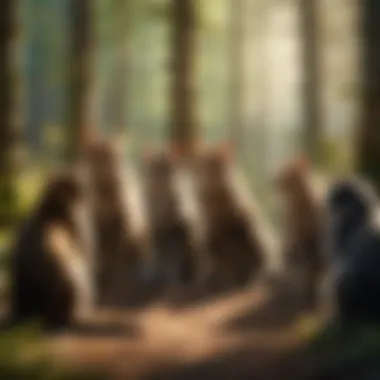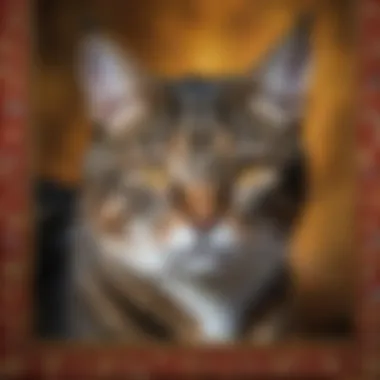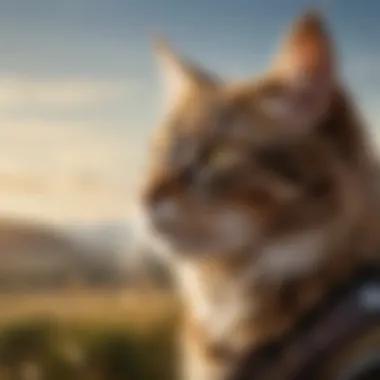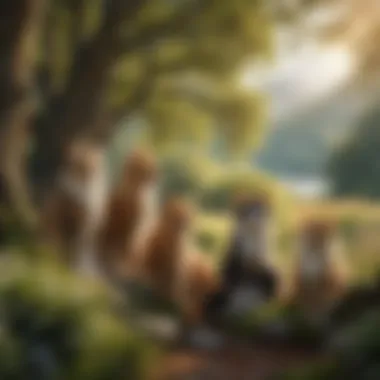Exploring Exclusion and Identity in Warrior Cats


Intro
In the world of literature, stories told through the lens of anthropomorphic cats bring a unique blend of adventure, drama, and insight into the complexities of social dynamics. One such series that captures the hearts and minds of readers, particularly those who cherish themes of belonging and identity, is the Warrior Cats saga. Here, we explore not just the narrative yarn woven by Erin Hunter, but also the intricate threads of exclusion and rebellion that define the characters' journeys.
As we journey through lush forests and battle-scarred territories, we'll meet warriors who are heroic in their quests and their struggles against societal norms. The narratives surrounding these cats symbolize much more than mere tales of survival; they urge us to reflect on our own environments where themes of ostracism and the yearning for community resonate deeply.
Основные жанры литературы
Классификация по жанрам
The Warrior Cats series, while primarily categorized under children’s literature or young adult fantasy, cannot be confined to such narrow definitions. The tapestry of this series incorporates elements from various literary genres, including:
- Adventure: Each book whisks readers into a world of peril and excitement, where characters face daunting challenges and fight for their clans.
- Fantasy: With a blending of magic and reality, these cats exhibit a society as rich and complex as any human civilization, featuring their own hierarchies and traditions.
- Drama: Interpersonal relationships and conflicts within the clans showcase emotional depth, illustrating struggles with identity and loyalty.
Особенности каждого жанра
The uniqueness of these genres apart from one another contributes to the richness of the Warrior Cats narrative. For instance, the adventure components keep readers on their toes, pushing them to invest in each character. However, the dramatic nuances elevate the story beyond mere escapism to a reflection on real-world issues. The fantasy elements allow for narratives where the impossible becomes possible, encouraging readers to ponder about their own limitations.
Рецензии на книги
Обзор популярных книг
The series, which began with Into the Wild, invites audiences to witness the initial struggles of Rusty, later known as Firestar, as he transitions from a domestic cat to a warrior of ThunderClan. This transformation embodies the classic hero's journey while touching deeply on themes of belonging. Each sequenced arc expertly unveils new characters like Graystripe, Sandstorm, and even darker figures like Scourge, illustrating various facets of a cat's experience.
Анализ литературных произведений
Through their journeys, the characters face issues like banishment, acceptance, and betrayal. These experiences mirror the chaos in human societies where the line between belonging and ostracism often blurs.
"In Warrior Cats, every battle transcends physical conflict; it often represents an internal struggle for identity and acceptance."
To break down the metamorphosis of key characters further, consider how some cats who started as outcasts find themselves becoming essential to clan survival. Their evolution emphasizes resilience, challenging societal expectations while championing the value of diversity.
As we dissect these narratives, we should keep in mind the vital role community plays in shaping identity, both in the world of Warrior Cats and our own. This delightful yet somber story unspools threads that bind warriors together, weaving a complex tapestry defined by loyalty, bravery, and the bittersweet nature of belonging.
Prologue to the Warrior Cats Phenomenon
The Warrior Cats series, penned by Erin Hunter, stands as a monumental work in contemporary children's literature. It weaves an intricate narrative that not only captures the imaginations of young readers but also resonates deeply with adults. Its unique portrayal of feline clans, each with distinct traits and social structures, provides an engaging lens through which we can explore themes of community and individuality. Understanding this phenomenon is crucial, as it sets the stage for analyzing the concepts of exclusion and belonging prevalent throughout the series.
Background on the Series
Launched in 2003, the Warrior Cats series consists of multiple arcs, each unfolding the lives of wild cats embodying the ideals of loyalty, courage, and survival. These narratives, rich in detail and conflict, draw parallels to human experiences, making the series relatable yet distinct. Each book dives into the struggles of a particular clan and its members, often dealing with personal growth amidst societal challenges. The structure allows for a diverse cast of characters, each offering a unique perspective shaped by their experiences within their respective environments. This combination of relatable themes and captivating storytelling makes it more than just another children’s book series.
The appeal of Warrior Cats transcends age barriers. Whether it’s the thrill of battle scenes or the heartwarming moments of camaraderie, readers find themselves immersed in a world that feels both foreign and familiar. The series encourages empathy, forcing readers to contemplate the often harsh realities of life, such as rivalry, loyalty, and the quest for acceptance.
Cultural Impact and Reception
The cultural significance of Warrior Cats cannot be understated. With a dedicated fanbase that spans across the globe, its influence on popular culture and online communities is profound. Many young adults who grew up with the series now share their experiences through fan fiction, art, and various forms of online discussions. This vibrant community engages on platforms such as reddit.com and facebook.com, where readers can discuss theories, share artwork, and connect over their shared love for the series.
The reception has been overwhelmingly positive, with critics and readers alike praising the series for its intricate plots and well-developed characters. Some have noted its ability to tackle complex issues such as discrimination and the nature of conflict, often reflecting society’s own challenges in a manner that is both accessible and thought-provoking.
“The appeal of Warrior Cats lies in its ability to mirror the intricacies of social dynamics, prompting discussions about acceptance and rejection that resonate deeply with its audience.”
The Concept of the Outcast in Warrior Cats
The theme of the outcast permeates the fabric of the Warrior Cats narrative, acting as a lens through which readers can examine deeper issues of identity, belonging, and social structure within the feline clans. The significance of this concept cannot be understated; it resonates with many who have felt like outsiders at some point in their lives. In understanding these outcast characters, one delves into complex interpersonal dynamics that mirror real-world conflicts regarding social hierarchies and differing desires for acceptance.
Defining the Outcast


To grasp the role of an outcast within the Warrior Cats universe, it's essential to pinpoint what this term embodies in the context of the story. An outcast isn't merely a cat who has been pushed aside due to flaws or transgressions; rather, it's about the shifting perceptions of belonging and the societal forces that dictate these dynamics. Outcasts can be individuals rejected for their differences, past mistakes, or simply for being born outside the expected norms of their clans.
Outcast cats often evoke sympathy, inviting readers to reflect on their motivations and struggles. At times, they may find camaraderie with others shunned by society, creating unexpected alliances. The concept of the outcast in Warrior Cats taps into universal feelings of alienation, making the narrative both poignant and relatable.
Notable Outcast Characters
Exiled Leaders
Exiled leaders serve as captivating embodiments of resilience in the face of rejection. These characters often symbolize a departure from traditional leadership expectations. For instance, Tigerstar, once a promising leader, becomes one of the most notorious exiles after his nefarious actions lead to his downfall. His narrative arc underscores the profound complexity of leadership — not only showcasing the consequences of ambition gone awry but also hinting at how power can corrupt.
Their unique feature lies in their turbulent pasts, which often involve grand aspirations twisted by betrayal and missteps. This allows them to gain a different perspective on clan loyalty, ultimately enriching the story. While these characters can inspire fear or mistrust, they also provoke thoughtful discussions about the nature of power and its fleeting grasp. The crucial aspect that stands out is their inherent longing for acceptance, which makes their ultimate isolation even more tragic yet relatable. This exploration of exiled leaders within Warrior Cats broadens the discussion to include themes of leadership failure and redemption.
Exiled Warriors
On the flip side, exiled warriors bring another layer of depth to understanding outcasts. Unlike leaders, these characters often deal with immediate consequences of their actions on a personal level. For example, Mapleshade, another pivotal outcast, illustrates how betrayal and desperation can breed alienation. Cast away due to her controversial choices, she becomes a symbol of misguided loyalty and inherent tragedy.
What sets exiled warriors apart is their capacity for personal growth amid adversity. Unlike their leader counterparts, these warriors do not hold power, but their journeys reflect the struggles of those who face societal rejection without ever having commanded respect. They often grapple with their pasts, seeking redemption while struggling against the chains of their history. The challenge of acceptance resonates strongly with readers, creating a bond with those who have faced similar societal pressures and stigma.
The beauty of portraying exiled warriors in this light is their relatable realization that belonging isn’t always a straightforward path. Their stories provide readers a glimpse into the often tortuous nature of relationships and societal acceptance — a reminder that everyone's journey to find a place in the world is unique and fraught with complexities.
Through examining exiled leaders and warriors, one can see how the concept of the outcast in Warrior Cats weaves a complex narrative tapestry that speaks to larger issues of identity, belonging, and the inherent human desire for recognition — something that transcends the feline clans and echoes in our everyday lives.
Themes of Rejection and Acceptance
When we delve into the depths of Warrior Cats, the themes of rejection and acceptance emerge as core tenets that drive the narrative forward. These themes are more than just background musings; they are crucial for character development and the unfolding of the intricate plots that keep readers coming back, clamoring for more. As the protagonists and antagonists navigate their world, the complexities of social acceptance significantly shape their journeys, impacting their decisions, emotional states, and ultimately, their fates.
The Journey from Outcast to Belonging
Character arcs depicting the journey from outcast to belonging are abundant in Warrior Cats, serving as powerful reflections of real-life struggles faced by many. Take, for instance, the character of Graystripe. Initially, he is firmly rooted in his Clan, but as set circumstances lead to his exile, Graystripe's evolution is evident. He transitions from a loyal warrior to an outcast, grappling with feelings of isolation and betrayal. His eventual path back to belonging encapsulates resilience and the ongoing search for identity amidst adversity.
This theme reverberates throughout the series, where characters often find themselves in exile, whether through their own actions or the decisions of others. For example, Mapleshade, driven by vengeance and despair after losing her family, is a tragic figure highlighting how betrayal and thwarted love can cement one’s status as an outcast. Each character’s journey underscores the profound desire for acceptance, illustrating that belonging is a steadfast human (or feline) aspiration.
Group Dynamics and Social Hierarchies
Social hierarchies within the Warrior Cats universe play a fundamental role in shaping the experiences of its characters. The Clans are structured in a way where acceptance is often contingent on rank, lineage, and loyalty. It’s a microcosm of broader societal dynamics, reflecting how hierarchy can dictate one’s standing and sense of belonging.
Take the Tigerstar narrative arc, for example. His rise from a notable lineage to one of a feared antagonist demonstrates how ambition and rejection within this high-stakes environment can lead to extreme actions. His quest for dominance stems from a deep-rooted need to prove his worth, showcasing the toxic nature of jealousy and desire for acceptance by one’s peers.
- The importance of social dynamics:
- They dictate interactions between characters.
- Influence personal ambitions and motivations.
- Create opportunities for conflict and resolution.
In this world, rejection often results in drastic actions—whether it be seeking vengeance, forging unlikely alliances, or launching outright rebellions. Here, we unearth a duality: while rejection can fuel fierce rebellion, it can also lead to profound self-discovery and the forging of new identities. The intricate dance of acceptance and rejection grants readers a lens to examine universal themes of love, loss, and the human (or feline) condition.
"Belonging is not just about fitting in; it’s about understanding one’s place in a larger narrative."
Through every tale of discord and harmony, Warrior Cats expertly weaves the complexities of acceptance into compelling storytelling, inviting the audience to reflect on their experiences with rejection and belonging.
Character Analysis: The Warrior Cats
A deep dive into the characters of Warrior Cats reveals not just the tapestry of individual lives but the broader narrative about acceptance, identity, and conflict within a community. This analysis is central to understanding the stories at play, as each character embodies the complexities of being part of a clan while grappling with personal demons and social dynamics. The protagonists and antagonists each offer valuable insights into the themes of leadership, rebellion, and the quest for belonging, making it crucial to dissect their journeys.
Protagonists: Triumphs and Turmoil
Leadership Qualities
When considering the leadership qualities displayed by the protagonists, it's essential to look at how these traits impact their respective clans. Leaders like Firestar represent bravery and vision, but what really sets them apart is their ability to inspire loyalty among their followers. This unique aspect of leadership breeds a sense of community and trust, often making these characters relatable. They are not simply warriors; they are the glue holding their clans together during tumultuous times.
Their leadership is often not without its drawbacks. The constant pressure to make the right decisions can lead to isolation, as these leaders may struggle to relate to their fellow warriors. This tension serves to complicate their character arcs. The pressure to be both a strong leader and a compassionate friend is a balancing act that many face in the series.


Personal Struggles
Examining personal struggles among protagonists reveals another layer to their narratives. Characters such as Bluestar exemplify how personal turmoil can manifest in leadership and decision-making. She faces immense internal conflicts that impact not just her own life but also the lives of those around her. This characteristic of personal struggle adds depth, making them multi-dimensional characters rather than straightforward heroes.
This internal conflict resonates with readers, especially when they see aspects of their own lives reflected in these characters. However, the downside is that such struggles can lead to a sense of helplessness, which sometimes drives these characters to make questionable decisions.
Antagonists: The Nature of Their Rebellion
Motivations Behind Actions
When delving into the motivations of antagonists in Warrior Cats, it’s crucial to acknowledge the fine line between antagonist and protagonist. Characters like Scourge have motivations rooted in past grievances and feelings of exclusion, shaping their actions as a form of rebellion. They stem from the feeling of being marginalized, which drives their opposition to the clans' social norms.
This complexity makes their motives relatable in a sense, allowing readers to reflect on real-world issues of inequality and exclusion. The consequence of these motivations, however, often leads to significant conflict, not only within their lives but also across the clans, revealing the darker side of ambition and revenge.
Consequences of Rebuff
Lastly, examining the consequences of rebuff in the lives of antagonists offers critical insights into their arcs. Characters face repercussions for their hostile actions, which often alienates them further, leading to a cycle of isolation and violence. The existence of enmity stems from their interpretation of acceptance, showing how the absence of belonging can lead to destructive behavior.
This dynamic illustrates a tragic aspect of their narratives—while they seek acceptance and power, their means often solidify their position as outcasts. Ultimately, the interplay between rejection and rebellion provides a fertile ground for discussions about morality, community, and the impact of outsider perspectives.
"The depth of a character isn't just in their choices; it’s in how those choices reflect their humanity or lack thereof."
In summary, the character analysis of Warrior Cats unveils the intricate workings of leadership and rebellion. Whether through the triumphs of the protagonists or the struggles faced by the antagonists, these narratives create a compelling exploration of the themes of belonging and identity, resonating deeply with readers and encouraging ongoing reflection on the nature of community.
Comparative Literature: Outcasts Across Genres
Understanding the theme of outcasts across various literary traditions sheds light on the universal narratives of rejection and acceptance found in the 'Warrior Cats' series. By drawing parallels between these stories and those from different cultures and eras, we not only enrich our grasp of the text but also gain insights into the human condition itself. Comparative literature allows readers to explore how outcast motifs resonate within varying social contexts, influencing both character development and plotlines. This exploration becomes crucial as we delve into the mindscapes of characters who feel alienated, enabling a deeper connection with the themes of identity and community.
Outcasts in Classic Literature
Examples from Notable Works
When we look at classic literature, we find numerous examples that resonate with the outcast theme. Characters like Hester Prynne from The Scarlet Letter and Jay Gatsby from The Great Gatsby embody the struggle of chasing belonging while grappling with societal judgment. Hester's experience of public shaming and her subsequent isolation speak volumes about how society alienates those who tread outside its stringent norms. Meanwhile, Gatsby's extravagant parties serve as a facade, masking his deep-rooted loneliness and desire for acceptance.
These characters offer invaluable perspectives not just through their individual arcs but also in how their narratives reflect broader societal issues. The prominent characteristic across these works is the exploration of social hierarchies—in both cases, tragic fractures in relationships stem from the characters' rejection by society. Hence, classics remind us why these outcasts are vital choices for our discussions surrounding the Warrior Cats series: they reveal intricate connections between acceptance and identity, showing readers how one’s status can shift dramatically based on choices and circumstances.
Some unique features of these notable works are their elaborate settings and the moral dilemmas presented. While The Scarlet Letter roots its conflicts in Puritanical values, The Great Gatsby navigates the complexities of the American Dream. These contrasting backgrounds expose readers to varied forms of marginalization and reflection upon their own conceptions of status, thus providing an advantage in understanding contemporary themes in 'Warrior Cats'.
Lessons Learned
Examining the lessons drawn from these classic narratives leads us to consider the broader implications of belonging and acceptance. A key takeaway is that the journey of outcasts is often marked by profound transformation, where characters wrestle with their identities against a backdrop of societal norms. In both Hester and Gatsby, we see how isolation can either crush the spirit or ignite resilience.
The prominent characteristic of lessons from these works lies in their capacity to evoke empathy. Readers can understand not only the struggles faced by these characters but also their relentless pursuit of their place in the world. The fact that even within their pain, these characters often serve as mirrors reflecting societal flaws makes them compelling figures for any study on marginalized voices.
In this context, the unique feature of classics is their well-woven narratives combined with deep psychological insights, serving to educate readers on the consequences of exclusion and the pieces of human connection. This resonates well with discussions in 'Warrior Cats', where similar lessons about community and rejection manifest ubiquitously.
Contemporary Reflections on Marginalization
In today's literary landscape, the conversation around marginalization has evolved, allowing new voices to emerge. Contemporary authors grapple with themes of exclusion in ways that speak directly to modern readers, reflecting social dynamics and cultural tensions. Literature now acknowledges a range of identities and experiences, giving voice to those who may feel sidelined in society.
Stories such as Angie Thomas's The Hate U Give reveal how systemic issues and societal prejudices affect marginalized individuals. These narratives help readers understand the necessity of discourse surrounding acceptance—underscoring the potency of literature as a tool for social critique and advocacy. Thus, they contribute significantly to a comprehensive discussion on outcast characters, bridging older narratives from classics with fresh insights relevant to today's society.
Connecting this back to 'Warrior Cats', one can see how both past and present literary works highlight the importance of understanding and empathizing with those the world tends to overlook. The interplay of past and contemporary themes creates a rich tapestry, illustrating that the complex relationship between outcasts and society remains as salient today as it did in any classical era.
Philosophical Underpinnings of Belonging
In exploring the narratives within the Warrior Cats franchise, it becomes evident that the themes of belonging permeate its very fabric. The philosophical underpinnings of belonging serve as a crucial focal point, shaping not only character arcs but also the overarching context of identity and community. This segment will delve into the inherent human need for belonging, delineating its significance while contrasting the complexities of acceptance and rejection.


Belonging: A Human Need
At its core, belonging is an intrinsic aspect of human existence. The necessity to feel connected, to be part of a group or community, is a catalyst for emotional well-being. Characters within Warrior Cats often grapple with this fundamental craving. For instance, Firestar’s tumultuous journey from a kittypet to the leader of ThunderClan illustrates a powerful narrative arc centered around this notion.
- Character Development: As Firestar integrates into clan life, it mirrors how individuals seek validation and acceptance among peers.
- Coping Mechanisms: Characters that find themselves on the outskirts, like Ashfur, showcase how the lack of belonging can lead to destructive behaviors and disillusionment.
In essence, the quest for belonging often manifests through trials and tribulations that enrich narrative depth. When characters experience rejection or acceptance, it resonates with readers, echoing their own societal experiences. This connection fosters empathy and understanding, making the narrative more poignant and relatable.
The Duality of Acceptance and Rejection
The interplay between acceptance and rejection is a central theme in Warrior Cats, creating an intricate tapestry that reflects the complexities of social dynamics. In the realm of the clans, acceptance is often tied to one's identity and actions, while rejection leads to isolation and introspection.
"Belonging demands not just enthusiasm but adherence to group norms, often compelling one to choose between selfhood and conformity."
Consider the character of Tigerstar. His story showcases the dark side of ambition, where rejection from his own clan pushes him into a path of villainy. Here, acceptance is contingent on loyalty and prestige, revealing how social hierarchies dictate interpersonal relationships. On the flip side, cats like Brambleclaw navigate their identities amidst conflicting roles, seeking acceptance not just from their clan but from their lineage as well.
- Conflict and Resolution: This duality brings about tension, driving plots forward as characters are forced to confront their choices and the repercussions of their actions on their sense of belonging.
- Moral Complexity: Young readers are presented with moral dilemmas that don’t just exhibit clear distinctions between good and evil. Rather, characters like Crowfeather show that the struggle for identity may lead to difficult choices, often resulting in a painful confrontation with both acceptance and rejection.
In summation, the Warrior Cats narrative effectively encapsulates the philosophical musings on belonging, reminding readers that the chase for connection often involves navigating through a labyrinth of social dynamics. As these characters tread the fine line between acceptance and rejection, they illuminate the myriad ways in which belonging shapes identity, influencing their relational landscapes for the better or worse.
The Future of Warrior Cats and Outcast Narratives
The anticipation surrounding the evolution of the Warrior Cats series is palpable among fans and scholars alike. As narratives shift, the thematic exploration of outcasts becomes ever more crucial. The world of Warrior Cats is not static; it grows, morphs, and presents new challenges that reflect changing societal views. This section shines a light on how ongoing storylines can steer the series toward fresh insights into belonging and rebellion, and what this means for its audience both young and older.
Evolving Storylines and Characters
The future promises a rich tapestry of developing characters and intricate plots. The creators seem keen on keeping the narrative alive by introducing new clans and challenges that echo the complexities of modern society. This evolution is vital; it allows characters once relegated to the margins to step into the spotlight, reflecting the experiences that many readers relate to.
Characters like Ashfur and Mapleshade highlight how deeply personal struggles intertwine with broader themes of acceptance and belonging. In upcoming installments, as these characters wrestle with their pasts, readers may see them navigating their identities in new and compelling ways. Moreover, new characters are being introduced that could challenge long-standing norms and expectations.
As clans face external threats and internal dilemmas, the actions and reactions of these characters can reveal a lot about the moral choices we must make in everyday life. But this isn't just about heroes or villains; it's about the gray areas in between.
"The lines between loyalty and betrayal are often blurred in the world of Warrior Cats, much like in our own lives."
Implications for Young Readers
For young readers, the implications of evolving Warrior Cats narratives are profound. These stories serve not only as entertainment but also as vessels for learning. They allow children to grapple with the ideas of exclusion and acceptance in a way that's approachable yet impactful. Reading about characters who face rejection, yet find resilience in their identities can help foster empathy among readers.
The growing complexity in the narratives encourages critical thinking about social issues. Children can see reflections of their own experiences in the struggles of characters who may feel different or left out. This generation of readers, growing up amidst rapid social changes, will benefit from seeing the consequences of actions and the nuances of belonging.
In essence, as the Warrior Cats universe continues to expand, it doesn’t just tell stories about cats—it speaks to the heart of human experiences. These narratives will likely push boundaries further, making space for discussions on identity, mental health, and the societal issues of today.
The End: The Enduring Legacy of the Warrior Cats
As we draw the curtains on this exploration of the intricate narratives woven within the Warrior Cats series, it becomes apparent that this phenomenon holds a deeper significance than mere entertainment for its readers. The themes of exclusion, belonging, and identity aren’t just plot devices; they resonate with our collective human experience. Through the lens of feline characters, readers—be they young or old—are encouraged to reflect upon their own lives and societal structures.
One striking element that stands out is the portrayal of outcasts within the clans. These characters often serve as mirrors reflecting our struggles and triumphs in seeking acceptance. The narrative encourages readers to consider their own sense of community and belonging, personalizing issues of marginalization. This not only makes for a compelling story but also provides a platform for dialogues about real-world implications.
Moreover, the way the Warrior Cats stories evolve showcases adaptability. As new generations of readers engage with the series, the themes remain relevant, morphing alongside cultural shifts. With an ever-expanding world filled with diverse characters, the narrative leaves one wondering: who will define the next chapter in this ongoing legacy? This openness invites creativity and interpretation, making the series a rich tapestry for further exploration.
Reflections on Identity and Community
It's impossible to ignore how integral identity is to the Warrior Cats universe. Characters struggle not only with their roles within their respective clans but also confront their personal identities. For instance, the internal battles of characters like Firestar and Tigerstar serve to highlight the tension between personal ambition and communal interests. Each character's journey underlines a quest not only to find their place in the world but also to navigate the sometimes murky waters of race, loyalty, and moral choices.
The series' depth invites discussions about community structures. Just as clans have hierarchies, our own communities do too, often governed by unspoken rules. This parallel resonates with readers, prompting them to ask tough questions about who gets marginalized and who rises to prominence.
As we contemplate these dynamics, the stories play a vital role in shaping how young readers understand relationships within their own lives. Are friendships built on mutual respect, or do they often mimic the power struggles witnessed in these feline clans? By engaging with such themes, readers are not just entertained—they're developing a framework to analyze their own social landscapes.
Final Thoughts on Marginalization
The concept of marginalization forms a core pillar of the Warrior Cats narrative, shining a light on how society deals with those who stray from norms. Characters like Brokenstar and Hawkfrost offer insight into the rebellions that arise from exclusion. Their stories are reminders that rebellion isn't always born from evil intent; sometimes, it emerges from the desperation to be acknowledged.
This poignancy lies in the fact that even those who oppose the status quo often face isolation. The struggles of these outcast characters present opportunities for readers to empathize with those at the fringes, highlighting the importance of inclusion and understanding.
Ultimately, the Warrior Cats series fosters an environment for conversations about acceptance and the complexities surrounding it. The narratives push us to ask a fundamental question: what do we do when we encounter an outcast? By navigating these challenging issues, the series leaves a lasting impression, forging connections between the struggles of fictional cats and the realities faced in our daily lives.



